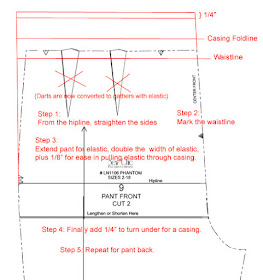About 15 years ago, when Expos were a new thing and I was still in college, I went with an Aunt to the now famous
Sewing and Stitchery Expo in Puyallup, Washington. At $2 a pop, we could take a class from any number of well known sewing educators. We left with notebooks full of information, agreeing not to return until we'd fully utilized the information we'd collected. That experience feels like a lifetime ago, and since then I've become an educator myself. It was time to make good on my commitment, so early this month Tricia and I took a drive up north to visit the show on Saturday where she and I were to participate in the
ASG style show.

Because I would have a second change for the show, I decided to come ready for my first scene, wearing an embellished version of Southern Belle. Right away,
Rhonda Pierce of
Schmetz Needles introduced herself. I told her that my favorite needle is the
Microtex, but I forgot to mention the
double needle sewing on the yoke of this dress. Can you see it here?

Then I stopped off at the
WSU booth who introduced me to
Rita Farro, who does the blogging, networking, and marketing for the show. She is a delightful person, and has a fabulous smile.
Soon it was time to line up for the fashion show. The runway prattle is made up from the questions I answered on the show application. My jaw dropped instantly when I heard "...and Laura has been sewing for 40 YEARS!" Everyone laughed. The MC added with a smile "I didn't write that!" I'm sure I look my age, but did they have to announce it? lol.

Being an avid Project Runway fan, I secretly hoped I'd get a chance to talk to Suede, whom we know from Season 5. He works for Simplicity now, and would be doing a stage presentation.You see, I would have liked to ask him what it was REALLY like to be on Project Runway. I had applied to be on the show some years back, just about the same season he was there. It's just as well I wasn't accepted because the retro genre was not doing very well with the judges at that time. For a split second he looked at me and looked as if he would come my way, but thought better of it and turned away.
Throughout the day I browsed the booths and stopped to talk with friends, acquaintances, complete strangers, giving away a few patterns of the Clara Bow Apron. It's incredibly easy to talk with people with a love for sewing in common. One really young girl, probably still in middle school, stopped me to say she liked my skirt. I gave her a sewing pattern. She looked at me in bewilderment. "But I only wanted to say I liked your skirt!"
 |
| 1920's Clara Bow Apron |
I have 5
Clara Bow Apron patterns that I'd like to give to you, my little dwindling group of followers here on blogger. (I suspect it's from severe neglect!) Hopefully this will make it up to you. This means that YOU have very good odds of getting a pattern. All you need do is:
1) be a follower
2) make a comment here about sewing topics you are interested in, OR the topic I've written about that you enjoyed most.
IF you want extra entry points, you can:
3) "like" on Facebook
4) sign up for the
newsletter
Do it before April 4, 2012. I'll draw 5 names from a bucket on April 5th.
Good Luck!
Post update: thank you for your entries, kind words, and suggestions. Best of all, Congratulations to the winners!






